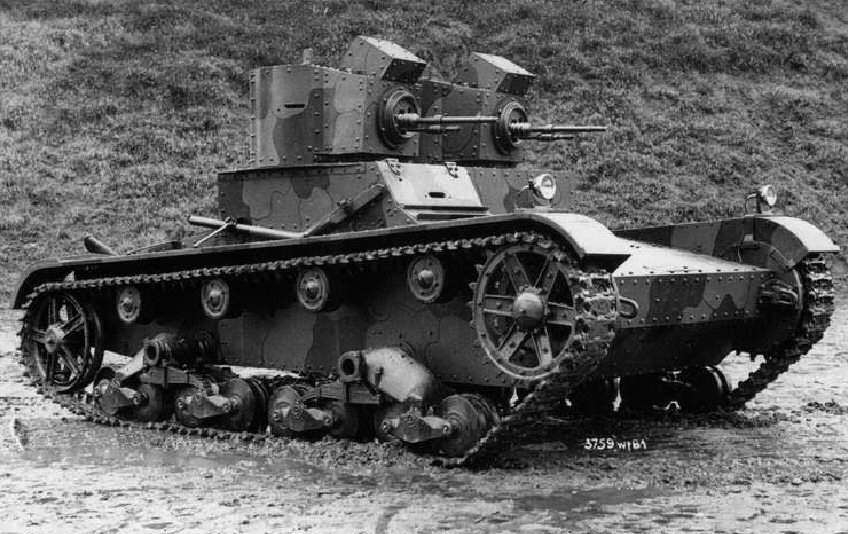Suomen lisäksi muita Vickers -panssarivaunun käyttäjiä olivat Puola (38 kpl),
Kiina (20), Siam (30), Bulgaria (8), Bolivia (3). Neuvostoliittoon myytiin vuonna 1931 valmistuslisenssi ja 15 vaunua ja se kehitti niiden pohjalta oman T-26 -versionsa.


Panssarivaunusuunnittelijoiden John Valentine Carden ja Vyvian Loyd suunnitteleman Mark E -vaunun ensimmäinen kappale valmistui vuonna 1928.
Sen runko rakentui edessä ja suurimmassa osassa tornia 25 mm:n paksuisesta ja rungon takaosassa 19 mm:n paksuisesta niitatusta teräslevystä. Moottorina oli 80 – 95 hevosvoimainen (60–70 kW) Armstrong Siddeley Puma, joka antoi vaunulle 35 km/h huippunopeuden maantiellä.
Suomeen hankittiin 32 vaunua vuosina 1936–1939. Ne piti varustaa 37 mm:n Bofors-tykillä, mutta hallitus päätti säästäväisyyssyistä ostaa vaunut ilman aseistusta. Lopulta vaunut varustettiin Valtion tykkitehtaan 37 mm:n vaunukanuunoilla. Talvisodan jälkeen vaunuihin asennettiin 45 mm:n neuvostoliittolaiset sotasaalistykit. Näin muokattuja T-26E -vaunuja käytettiin jatkosodan taisteluissa.
----------------------------
The Vickers 6-Ton Tank or Vickers Mark E was a British light tank designed as a private project at Vickers. It was not purchased by the British Army, but was picked up by a large number of foreign armed forces and was licenced with few improvements by the Soviets as the T-26. It was also the direct predecessor of the Polish 7TP tank. By the start of World War II it was the second most common tank design in the world after the Renault FT
Type: Light tank
Place of origin: United Kingdom
Specifications
Weight: 7.3 tonnes
Length: 4.88 m (16 ft 0 in)
Width: 2.41 m (7 ft 11 in)
Height: 2.16 m (7 ft 1 in)
Crew: 3
Armour: 13 mm
Armament: 47 mm gun (Type B only) 50 rounds + 1 or 2 machine guns
Engine: Armstrong Siddeley Puma petrol 80–98 hp (60–70 kW)
Power/weight: 11–13 hp/tonne
Suspension: leaf spring bogie
Range:160 km (99 mi)
Speed:35 km/h (22 mph)
---------------------------
The first Mark E was built in 1928 by a design team that included the famed tank designers John Valentine Carden and Vivian Loyd. The hull was made of riveted steel plates, 1 inch (25 mm) thick at the front and over most of the turrets, and about 3/4 inch (19 mm) thick on the rear of the hull. The power was provided by an Armstrong Siddeley Puma engine of 80–95 horsepower (60–70 kW) (depending on the version), which gave it a top speed of 22 mph (35 km/h) on roads.
The suspension used two axles, each of which carried a two-wheel bogie to which a second set of bogies was connected with a leaf spring. Upward movement of either set of bogies would force the other down through the spring. This was considered to be a fairly good system and offered better than normal cross-country performance although it could not compare with the contemporary Christie suspension. High strength steel tracks gave over 3000 miles (5000 km) of life which was considerably better than most designs of the era.
The tank was built in two versions:
Type A with two turrets, each mounting a Vickers machine gun.
Type B with a single two-man turret mounting a single machine gun and a short-barreled 47 mm cannon OQF 3-pdr Gun.
The Type B proved to be a real innovation, it was found that the two-man turret dramatically increased the rate of fire of either weapon, while still allowing both to be fired at the same time. This design, which they referred to as a duplex mounting, became common on almost all tanks designed after the Mark E.
The British Army evaluated the Mark E, but rejected it, apparently due to questions about the reliability of the suspension. Vickers then started advertising the design to all buyers.... ....and soon received a trickle of orders eventually....

... including USSR,

Poland,

Bolivia,

Siam,
Finland,

Portugal,

China

and Bulgaria.
A Thai order was placed, but taken over by the British when the war started.
Vickers built a total of 153 (the most common figure) Mark E's.
Experience with the Polish machines showed that the engine tended to overheat due to poor airflow over the air-cooled Puma engine. This was addressed by the addition of large air vents on either side of the hull. For a new Belgian order the design was modified to use the Rolls-Royce Phantom II water-cooled engine instead.
This engine would not fit in the rear, and had to be mounted along the left side of the tank, requiring the turret to be moved to the right and rearward. One example of the resulting Mark F was tested by Belgium, but rejected. Nevertheless the new hull was used, with the older engine, in the sales to Finland and Siam.



The twin turret version looks cool!
VastaaPoistaHi
PoistaYep. It is a good-looking
Three strong characters who will remain in the history of tank
Renaut FT
Vickers E
T-34